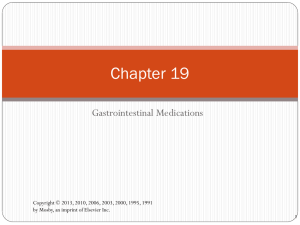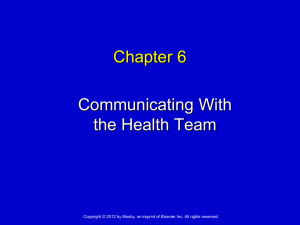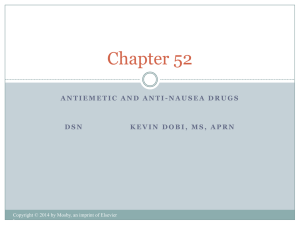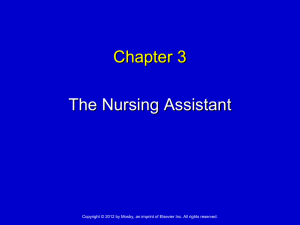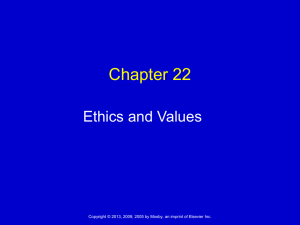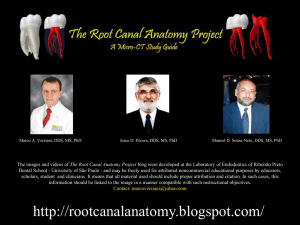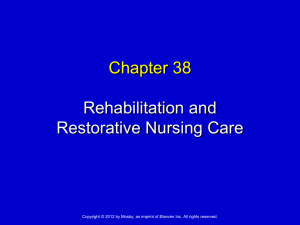Pharmacology and the Nursing Process, 4th ed. Lilley/Harrington
advertisement
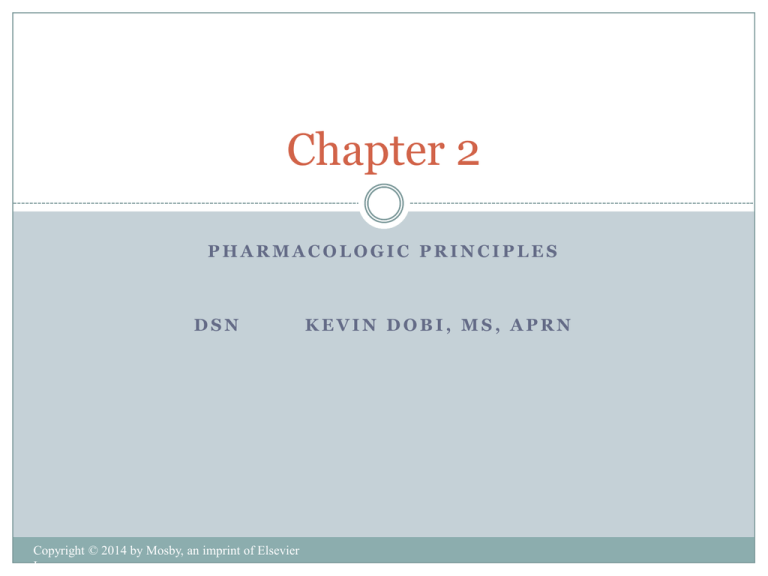
Chapter 2 PHARMACOLOGIC PRINCIPLES DSN Copyright © 2014 by Mosby, an imprint of Elsevier Inc. KEVIN DOBI, MS, APRN Pharmacologic Principles 2 Drug Any chemical that affects the physiologic processes of a living organism Pharmacology Study or science of drugs Copyright © 2014 by Mosby, an imprint of Elsevier Inc. Drug Names Chemical name 3 Describes the drug’s chemical composition and molecular structure Generic name (nonproprietary name) Name given by the United States Adopted Names Council Trade name (proprietary name) The drug has a registered trademark; use of the name is restricted by the drug’s patent owner (usually the manufacturer) Copyright © 2014 by Mosby, an imprint of Elsevier Inc. Chemical, Generic, and Trade names and Chemical Structure of Ibuprofen 4 Copyright © 2014 by Mosby, an imprint of Elsevier Inc. Pharmacologic Principles 5 Pharmaceutics Pharmacokinetics Pharmacodynamics Pharmacotherapeutics Pharmacognosy Pharmacoeconomics Copyright © 2014 by Mosby, an imprint of Elsevier Inc. Pharmaceutics 6 The study of how various drug forms influence the way in which the drug affects the body Copyright © 2014 by Mosby, an imprint of Elsevier Inc. Pharmacokinetics 7 The study of what the body does to the drug Absorption Distribution Metabolism Excretion Copyright © 2014 by Mosby, an imprint of Elsevier Inc. Classroom Response Question 8 The nurse is giving a medication that has a high first-pass effect. The health care provider has changed the route from IV to PO. The nurse expects the oral dose to be A. higher because of the first-pass effect. B. lower because of the first-pass effect. C. the same as the IV dose. D. unchanged. Copyright © 2014 by Mosby, an imprint of Elsevier Inc. Pharmacodynamics 9 The study of what the drug does to the body The mechanism of drug actions in living tissues Drug-receptor relationships Copyright © 2014 by Mosby, an imprint of Elsevier Inc. Phases of Drug Activity 10 Copyright © 2014 by Mosby, an imprint of Elsevier Inc. Classroom Response Question 11 A patient is complaining of severe pain and has orders for morphine sulfate. The nurse knows that the route that would give the slowest pain relief would be which route? A. B. C. D. IV IM Subcut PO Copyright © 2014 by Mosby, an imprint of Elsevier Inc. Pharmacotherapeutics 12 The clinical use of drugs to prevent and treat diseases Defines principles of drug actions—the cellular processes that change in response to the presence of drug molecules Drugs are organized into pharmacologic classes Copyright © 2014 by Mosby, an imprint of Elsevier Inc. Pharmacognosy 13 The study of natural (versus synthetic) drug sources (i.e., plant, animals, minerals) Copyright © 2014 by Mosby, an imprint of Elsevier Inc. Pharmaceutics 14 Different drug dosage forms have different pharmaceutical properties. Dosage form determines the rate of drug dissolution (dissolving of solid dosage forms and their absorption from the GI tract). Enteric-coated tablets Extended-release forms Copyright © 2014 by Mosby, an imprint of Elsevier Inc. Classroom Response Question 15 A patient is prescribed ibuprofen 200 mg PO every 4 hours as needed for pain. The pharmacy sends up enteric-coated tablets, but the patient refuses the tablets, stating that she cannot swallow pills. What will the nurse do? A. Crush the tablets and mix them with applesauce or pudding. B. Call the pharmacy and ask for the liquid form of the medication. C. Call the pharmacy and ask for the IV form of the medication. D. Encourage the patient to try to swallow the tablets. Copyright © 2014 by Mosby, an imprint of Elsevier Inc. 16 Copyright © 2014 by Mosby, an imprint of Elsevier Inc. Pharmacokinetics 17 A drug’s time to onset of action, time to peak effect, and duration of action Study of what happens to a drug from the time it is put into the body until the parent drug and all metabolites have left the body Copyright © 2014 by Mosby, an imprint of Elsevier Inc. Pharmacokinetics: Absorption 18 Movement of a drug from its site of administration into the bloodstream for distribution to the tissues Bioavailability First-pass effect Copyright © 2014 by Mosby, an imprint of Elsevier Inc. Routes 19 A drug’s route of administration affects the rate and extent of absorption of that drug Enteral (GI tract) Parenteral Topical Copyright © 2014 by Mosby, an imprint of Elsevier Inc. Enteral Route 20 The drug is absorbed into the systemic circulation through the oral or gastric mucosa or the small intestine Oral Sublingual Buccal Rectal (can also be topical) Copyright © 2014 by Mosby, an imprint of Elsevier Inc. Parenteral Route 21 Intravenous (fastest delivery into the blood circulation) Intramuscular Subcutaneous Intradermal Intraarterial Intrathecal Intraarticular Copyright © 2014 by Mosby, an imprint of Elsevier Inc. Topical Route 22 Skin (including transdermal patches) Eyes Ears Nose Lungs (inhalation) Rectum Vagina Copyright © 2014 by Mosby, an imprint of Elsevier Inc. Classroom Response Question 23 The nurse is preparing to administer a transdermal patch to a patient and finds that the patient already has a medication patch on his right upper chest. What will the nurse do? A. Remove the old medication patch and notify the health care provider B. Apply the new patch without removing the old one C. Remove the old patch and apply the new patch in the same spot D. Remove the old patch and apply the new patch to a different, clean area Copyright © 2014 by Mosby, an imprint of Elsevier Inc. Distribution 24 The transport of a drug by the bloodstream to its site of action Protein-binding Water-soluble vs. fat-soluble Blood-brain barrier Areas of rapid distribution: heart, liver, kidneys, brain Areas of slow distribution: muscle, skin, fat Copyright © 2014 by Mosby, an imprint of Elsevier Inc. Protein Binding of Drugs 25 Copyright © 2014 by Mosby, an imprint of Elsevier Inc. Metabolism/Biotransformation 26 The biochemical alteration of a drug into an inactive metabolite, a more soluble compound, a more potent active metabolite, or a less active metabolite Liver (main organ) Skeletal muscle Kidneys Lungs Plasma Intestinal mucosa Copyright © 2014 by Mosby, an imprint of Elsevier Inc. Drug Transport in the Body 27 Copyright © 2014 by Mosby, an imprint of Elsevier Inc. Metabolism/Biotransformation (cont’d.) 28 Factors that decrease metabolism Cardiovascular dysfunction Renal insufficiency Starvation Obstructive jaundice Slow acetylator Ketoconazole therapy Copyright © 2014 by Mosby, an imprint of Elsevier Inc. Metabolism/Biotransformation (cont’d) 29 Factors that increase metabolism Fast acetylator Barbiturate therapy Rifampin therapy Phenytoin therapy Copyright © 2014 by Mosby, an imprint of Elsevier Inc. Excretion 30 The elimination of drugs from the body Kidneys (main organ) Liver Bowel Biliary excretion Enterohepatic recirculation Copyright © 2014 by Mosby, an imprint of Elsevier Inc. Renal Drug Excretion 31 Copyright © 2014 by Mosby, an imprint of Elsevier Inc. Half-life 32 The time it takes for one half of the original amount of a drug to be removed from the body A measure of the rate at which a drug is removed from the body Most drugs considered to be effectively removed after about five half-lives Steady state Copyright © 2014 by Mosby, an imprint of Elsevier Inc. The Movement of Drugs Through the Body 33 Drug actions The cellular processes involved in the drug and cell interaction Drug effect The physiologic reaction of the body to the drug Includes onset, peak, and duration of action Copyright © 2014 by Mosby, an imprint of Elsevier Inc. Onset, Peak, and Duration 34 Onset The time it takes for the drug to elicit a therapeutic response Peak The time it takes for a drug to reach its maximum therapeutic response Duration The time a drug concentration is sufficient to elicit a therapeutic response Copyright © 2014 by Mosby, an imprint of Elsevier Inc. 35 Copyright © 2014 by Mosby, an imprint of Elsevier Inc. Therapeutic Drug Monitoring 36 Peak level Highest blood level Trough level Lowest blood level Copyright © 2014 by Mosby, an imprint of Elsevier Inc. Pharmacodynamics: Mechanisms of Action 37 Receptor interactions Enzyme interactions Nonselective interactions Copyright © 2014 by Mosby, an imprint of Elsevier Inc. 38 Copyright © 2014 by Mosby, an imprint of Elsevier Inc. 39 Copyright © 2014 by Mosby, an imprint of Elsevier Inc. Pharmacotherapeutics: Types of Therapies 40 Acute therapy Maintenance therapy Supplemental/replacement therapy Palliative therapy Supportive therapy Prophylactic therapy Empiric therapy Copyright © 2014 by Mosby, an imprint of Elsevier Inc. Contraindications 41 Any characteristic of the patient, especially a disease state, that makes the use of a given medication dangerous for the patient It is important to assess for contraindications! Copyright © 2014 by Mosby, an imprint of Elsevier Inc. Monitoring 42 Evaluating the clinical response of the patient to the treatment One must be familiar with the drug’s: Intended therapeutic action (beneficial) Unintended but potential adverse effects (predictable, adverse drug reactions) Copyright © 2014 by Mosby, an imprint of Elsevier Inc. Monitoring (cont’d) 43 Therapeutic index Drug concentration Patient’s condition Tolerance and dependence Drug interactions (additive effect, synergistic effect, antagonistic effect, incompatibility) Adverse drug events Copyright © 2014 by Mosby, an imprint of Elsevier Inc. Monitoring (cont’d) 44 Adverse drug reactions Pharmacologic reactions, including adverse effects Hypersensitivity (allergic) reaction Idiosyncratic reaction Drug interaction Copyright © 2014 by Mosby, an imprint of Elsevier Inc. Other Drug-Related Effects 45 Teratogenic Mutagenic Carcinogenic Copyright © 2014 by Mosby, an imprint of Elsevier Inc. Pharmacognosy 46 Four main sources for drugs Plants Animals Minerals Laboratory synthesis Copyright © 2014 by Mosby, an imprint of Elsevier Inc. Toxicology 47 The study of poisons and unwanted responses to drugs and other chemicals Overlaps with pharmacotherapeutics Copyright © 2014 by Mosby, an imprint of Elsevier Inc. 48 Copyright © 2014 by Mosby, an imprint of Elsevier Inc. The End 49 Copyright © 2014 by Mosby, an imprint of Elsevier Inc.
